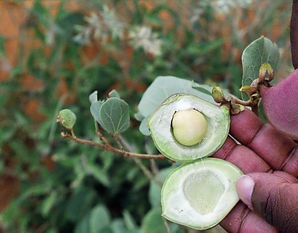Marama bean crop improvement using tissue culture and mutation breeding approaches.

Namibia University of Science and Technology
_edited.jpg)
Marama bean (Tylosema esculentum). Photo credit: Dr Percy Chimwamurombe
PROJECT OVERVIEW
Background
Marama bean (Tylosema esculentum) is a wild perennial edible legume that grows in the Namibian desert. It is often referred to as “green gold” due to the high protein content found in its seeds, estimated to be between 29% and 39%, surpassing the protein content of soybeans and chickpeas (approximately 23%). Marama bean demonstrates remarkable resilience, tolerating both summer temperatures as high as 50˚C and freezing winter conditions, and is capable of surviving in areas where surface water is available for only eight weeks each year.
The aim of this research project is to accelerate the improvement of the marama bean beyond what can be achieved through traditional breeding methods. The project will employ mutation breeding on several marama bean varieties sourced from the seed bank at NUST. In addition, tissue culture techniques will be used to shorten the juvenile period of this legume.
Objectives
1. Reduce the juvenile phase (time-to-seed) using tissue culture and hormone treatments on adventitious roots from immature marama explants and test if this will reduce the juvenile stages.
2. Apply mutagenesis breeding to produce stable and desirable traits.
_edited.jpg)
Dr Percy Chimwamurombe, with a marama bean tuber.

i
_edited.jpg)
ii

iii
Marama bean plants (i) and pods (ii and iii). Photo credit: Dr Percy Chimwamurombe.
PROJECT TEAM MEMBERS

Dr Percy Chimwamurombe
PI
NUST, Namibia

Dr. Jeya Kennedy
Plant Biotechnologist & Orchid Tissue Culture Specialist
NUST, Namibia

